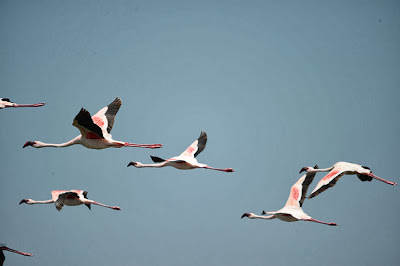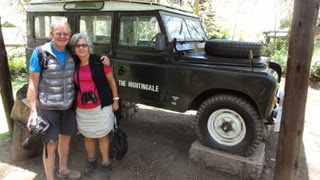11/9/13
We had 2 vehicles and 2 driver /guides for the 9 of us plus Clive. Every day we divided into groups of 5 and changed the combinations of people usually daily. It worked well.
The next morning we got up early and left
at 6.15 while it was still dark.
We were on a big cat hunt. After a fruitless search for them the day before I wasn’t too hopeful. We saw flamingoes in the morning mist – gorgeous.

The African drivers / guides communicate with each other on radio and share sightings.
We were on a big cat hunt. After a fruitless search for them the day before I wasn’t too hopeful. We saw flamingoes in the morning mist – gorgeous.

The African drivers / guides communicate with each other on radio and share sightings.
As became a common practice during the trip
we would be driving slowly along and then suddenly we would increase speed or
turn around and hurtle off towards the action. On this occasion we were
supposed to see lions. Then we slowed down because Norman heard that they’d
gone. We kept looking anyway. Then all of a sudden we saw them. 5 young ones
just off the road wandering around. They went back and forward across the road
and let us look at them for several minutes.
Then we reversed to where there
was an old magnificent male lion lying about 3 metres off the side of the road.
Glorious mane and not the least disturbed that we were parked nearby. He
watched us and we watched him for several minutes. Eventually he got up and we
could see that he wasn’t walking very well and had quite a limp. He seemed to
walk easier after a few steps and walked a few meters and then lay down in the
bushes. (my thought was that some glucosamine might help!) Then we saw that
there was another male close by. They lay down quite close to each other,
looked like they were settled for the day, and we couldn’t see them well so we
left.
He's still got his tonsils I think!
Quite soon after we saw some more lions – again quite young ones walking around. Clive thought they had had a kill because they looked quite full and smelt of what might have been an old carcass. Eventually they lay down and started licking each other which is what they do after a kill apparently. Amazing to see.
Back at 9am for breakfast and then off again into the park.
Baboons hang around the waterhole near the restaurant at Lake Nakura Lodge. Sometimes they try to come inside and get food. We’ve been told not to leave our room doors or windows open because they could come in.
A Masai man – Jeremiah has been employed to stop them getting into the restaurant. He stands with a stick and frightens them off. They are building an electric fence at present and he will be able to go back to his normal work with his cattle when this is finished, which he told me he’s looking forward to. The male baboons recognise he is the barrier to their food source and sometimes ambush him together. He said if he shows any fear they will smell it and attack him. So far he’s winning.
On the next drive we saw lots of buffalo –
many who’d been swimming in mud - some very small baby impala, lots of giraffes
and zebras, warthogs, jackals etc. We were looking for leopards but didn’t find
any.
Pretty muddy buffalo eh!
These cattle egret love to hang around grazing animals and eat the insects that are disturbed.
Our first rhinoceros. A lone large male.
This cute little impala was very young. They are very vulnerable to predators when they're so young but the herd tries to protect them and surround them if they sense danger.
 In the afternoon we went out again and saw lots of game but no leopards until we were nearly ready to return and the drivers heard on the radio that some people had seen leopards. Well did we move! Driving up to 80 – 100 kph on dirt roads with lots of potholes is exciting! It was worth it because we saw 3 leopards. 2 were a long way away but visible with binoculars. They were lying on a log. Bob got this photo with his long lens and maximum magnification. Can you see there are two? Difficult I know but an exciting first sighting for us. The third was walking through long grass and only partially visible. Their camouflage is amazing. We knew where this leopard had walked to and it wasn’t far away from us but it just seemed to vanish – probably by lying down.
In the afternoon we went out again and saw lots of game but no leopards until we were nearly ready to return and the drivers heard on the radio that some people had seen leopards. Well did we move! Driving up to 80 – 100 kph on dirt roads with lots of potholes is exciting! It was worth it because we saw 3 leopards. 2 were a long way away but visible with binoculars. They were lying on a log. Bob got this photo with his long lens and maximum magnification. Can you see there are two? Difficult I know but an exciting first sighting for us. The third was walking through long grass and only partially visible. Their camouflage is amazing. We knew where this leopard had walked to and it wasn’t far away from us but it just seemed to vanish – probably by lying down.






























































